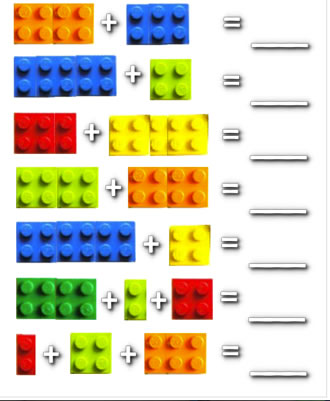LEGO Math
In this lesson, children will practice counting and adding whole numbers using LEGO blocks.
Lesson for:
Toddlers/Preschoolers
(See Step 5: Adapt lesson for toddlers or preschoolers.)
Content Area:
Algebra
Numbers and Operations
Learning Goals:
This lesson will help toddlers and preschoolers meet the following educational standards:
- Understand numbers, ways of representing numbers, relationships among numbers and
number systems - Understand meanings of operations and how they relate to one another
- Compute fluently and make reasonable estimates
- Use mathematical models to represent and understand quantitative relationships
Learning Targets:
After this lesson, toddlers and preschoolers should be more proficient at:
- Counting with understanding and recognizing “how many” in sets of objects
- Developing understanding of the relative position and magnitude of whole numbers and of ordinal and cardinal numbers and their connections
- Developing a sense of whole numbers and representing and using them in flexible ways, including relating, composing and decomposing numbers
- Understanding various meanings of addition and subtraction of whole numbers and the relationship between the two operations
- Understanding the effects of adding and subtracting whole numbers
- Developing and using strategies for whole-number computations, with a focus on addition and subtraction
- Developing fluency with basic number combinations for addition and subtraction
- Using a variety of methods and tools to compute, including objects, mental computation, estimation, paper and pencil and calculators
- Illustrating general principles and properties of operations, such as commutativity, using specific numbers
- Modeling situations that involve the addition and subtraction of whole numbers, using objects, pictures and symbols

LEGO Math
Lesson plan for toddlers/preschoolers
Step 1: Gather materials.
- LEGO blocks
- Recording sheets (The children will be counting the round tops of the LEGO blocks. You can either copy the LEGO blocks and create a recording sheet or simply draw colored rectangles and squares with dots on them to represent the LEGO blocks)

Note: Small parts pose a choking hazard and are not appropriate for children age five or under. Be sure to choose lesson materials that meet safety requirements.
Step 2: Introduce activity.
- Engage the children in a conversation about LEGO blocks. Do they count LEGO blocks while building with them? Which LEGO blocks are best to build with? What do they typically build when using LEGO blocks?
- Explain that they they are going to use the LEGO blocks for counting and adding. Explain that they are not going to count the number of blocks. Instead, they are going to count the connecting dots on the tops of the LEGO blocks. Say: “We will be adding LEGO blocks together and counting the total number of connecting dots on the tops of the blocks.”
- Model the activity by using two different LEGO blocks. Introduce the recording sheet. Explain that the children will look at the LEGO blocks, add the number of dots and put the total number of dots on the given line, after the equal sign. Say: “The orange block has eight dots and the blue block has six dots.” Ask: “How many dots do the two LEGO blocks have in all?”
- Have extra LEGO blocks or other counting manipulatives available if the children need manipulatives to help them count.
Step 3: Engage children in lesson activities.
- Distribute recording sheets and LEGO blocks.
- Work through the first problem together as a group. Once you are confident that the children understand the activity, allow them to work independently.
Additional Extensions
- Create a new recording sheet that the children can use to add two LEGO blocks to another LEGO block or add two LEGO blocks to two LEGO blocks.
- Create a recording sheet that the children can use to subtract a smaller LEGO block from a larger LEGO block.
Step 4: Vocabulary.
- Add: To increase the number. “When I add four dots on a LEGO block to four dots on another LEGO block, I get eight dots on both LEGO blocks.”
- Equals: The amount. “When I have four dots plus four dots, that equals eight dots on both LEGO blocks.”
- Altogether: In total. “How many dots are there altogether?”
- Count: To identify the amount of something by number: “How many dots do you have? 1-2-3!” (Point to each dot while saying “1-2-3”).
- Total: The complete amount of items counted. “What is the total number of dots on both LEGO blocks?”
Step 5: Adapt lesson for toddlers or preschoolers.
Adapt Lesson for Toddlers
Toddlers may:
- Not easily count up to or beyond 10
Child care providers may:
- Have the children count the LEGO blocks, not the dots on top of the LEGO blocks
- Use smaller LEGO blocks with combined dots of 10 or less
Adapt Lesson for Preschoolers
Preschoolers may:
- Easily count single- and double-digit numbers
- Be able to add single-digit numbers
Child care providers may:
- Create a new recording sheet that the children can use to add two LEGO blocks to another LEGO block or add two LEGO blocks to two LEGO blocks
- Create a recording sheet that the children can use to subtract a smaller LEGO block from a larger LEGO block
Suggested Books
- The LEGO Book by Daniel Lipkowitz (New York: DK Children, 2012)
- Hershey’s Kisses Addition by Jerry Pallotta (New York: Scholastic, 2001)
- Double Play: Monkeying Around with Addition by Betsy Franco (Berkeley, CA: Tricycle Press, 2011)
Music and Movement
Outdoor Connections
The following activity can be done indoors or outdoors. Have the children build with LEGO blocks and then count how many LEGO blocks they used in their creations. Set a theme. For example, tell the children to build spaceships and then label how many LEGO blocks they used to build their spaceships. This allows for many extensions: graphing, more than, less than, differences, similarities, etc.
Comment on this lesson